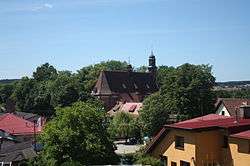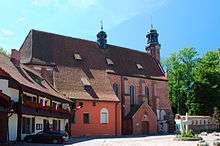Żukowo
Żukowo [ʐuˈkɔvɔ] (Kashubian: Żukòwò, German: Zuckau, Latin: Sucovia) is a town in Kartuzy County, in the Pomeranian Voivodeship of northern Poland in the cultural region of Kashubia, with 6,236 inhabitants (2005). It is located along the Radunia river in the historic Pomerelia, about 19 km (12 mi) southwest of Gdańsk.
Żukowo | |
|---|---|
 Assumption of the Virgin Mary Church | |
 Coat of arms | |
 Żukowo | |
| Coordinates: 54°20′45″N 18°21′38″E | |
| Country | |
| Voivodeship | Pomeranian |
| County | Kartuzy |
| Gmina | Żukowo |
| Area | |
| • Total | 4.73 km2 (1.83 sq mi) |
| Population (2018) | |
| • Total | 6,688 |
| • Density | 1,400/km2 (3,700/sq mi) |
| Website | http://www.zukowo.pl |
It is one of the youngest towns in Poland, having received its city charter in 1989, and a cultural centre of the Kashubians.
History



Żukowo was the site of a Premonstratensian (Norbertine) monastery established about 1209[1] by Duke Mestwin I of Pomerania. The church features alabaster figures made in England. Here the Kashubian embroidery is still in use.[2] In Kashubia decorated women's bonnets were called zlotnice. Norbertine nuns in Żukowo made them in the 18th century. The embroidery was made with silver or gold threads. Women's bonnets designing contains motifs similar to church embroideries and this were based on baroque style. The nuns were teaching noblemen's and rich Kashubian peasants' daughters how to make embroidery – one of them was Marianna Okuniewska from Żukowo (born 1818).
Zlotnice were very expensive. The nuns probably stopped making them after the region was annexed by the Kingdom of Prussia during the First Partition of Poland in 1772 and the nunnery was closed in 1834. Granddaughters of Marianna – Zofia (born 1896) and Jadwiga Ptach started reaktivating of Kashubian embroidery called Żukowo's school before World War II. Embroideries made here in this time link often to the zlotnice bonnets and antependiums. Kashubian embroidery was again made after the war at Żukowo. Its main decorative elements are flowers and plant motifs. Embroidresses who are deserved for the Kashubian embroidery, for example are: Marianna Ptach, Zofia Ptach, Jadwiga Ptach, Maria Nowicka, Wanda Dzierzgowska, Bernadeta Reglinska,[3] Ewa Wendt and others. Zukowo school of Kashubian embroidery is important intangible cultural heritage. The town's coat of arms since 1989 feature among other things the palmette of Kashubian embroidery.
During World War II the town was under German occupation, and was a place of internment for POWs from the United Kingdom. There are graves of Stutthof prisoners in Żukowo.
Literature
Notable people
- Wiesław Mering (born 1945 in Żukowo) a Polish Roman Catholic bishop.
References
- Hirsch, Theodor. Das Kloster Zuckau und seine Umgebungen während des 13. und 14. Jahrhunderts. Neue Preußische Provinzialblätter. Band 3 (Jahrgang 1853, Januar–Juni), Königsberg 1853, p. 4-71.
- http://szkola.interklasa.pl/f019/strona/ang/embroidery.html
- http://www.nck.org.pl/en/event/2804/the-colours-of-pomeranian-tradition-kashubian-embroidery-exhibition
External links
- Official website
- Kashubian embroidery
- Żukowo
- Zukowo school of Kashubian embroidery
- Kashubian embroidery in Canada
| Wikimedia Commons has media related to Żukowo. |